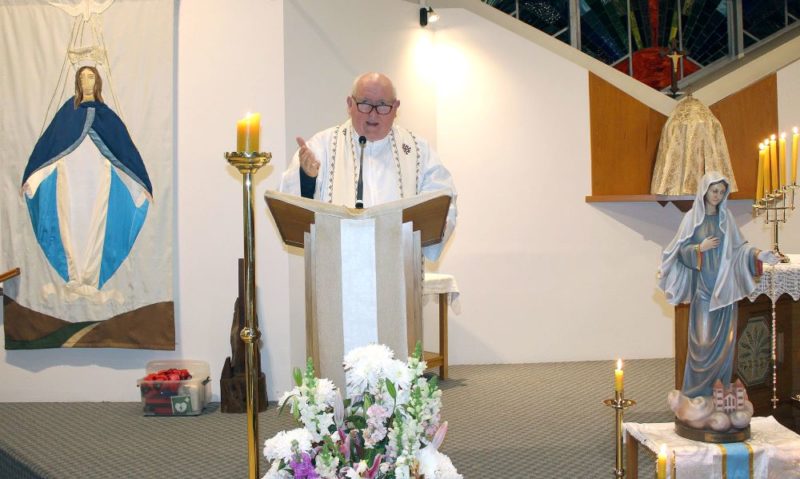What did Bishop Jean-Baptiste Pompallier understand when, in 1838, he dedicated his mission in Aotearoa New Zealand to “the Most Holy Virgin under the name of the Assumption”?
That was the question posed by Te Kupenga Catholic Theological College lecturer Fr Merv Duffy, SM, at a talk at Our Lady, Star of the Sea church in Howick on the evening of August 15.
Bishop Pompallier also consecrated the whole Vicariate of Western Oceania to Mary under the title of the Immaculate Conception, Fr Duffy added.
“Marian dogmas were a hot topic in the Church at that stage of history,” the Marist priest said.
Sixteen years after these actions of Bishop Pompallier’s, Pope Pius IX would declare that the doctrine of the Immaculate Conception of Mary is a doctrine revealed by God and therefore is to be believed firmly and constantly by all the faithful. And in 1950, Pope Pius XII defined the dogma of the Assumption of the Blessed Virgin in his Apostolic Constitution Munificentissimus Deus.
“So, Bishop Pompallier was good at backing titles that were to subsequently make it as infallibly defined dogmas of the Church,” Fr Duffy said.
But what did he understand by “the Most Holy Virgin under the name of the Assumption”? What does the title mean?
Fr Duffy mentioned Mary in the Scriptures, where she is the Mother of Jesus, and is written about at places such as Bethlehem, Nazareth, Cana and Calvary. From the Scriptures, Christians also know that John took her from the foot of the cross into his house, and that she was one of those praying in the Upper Room at Pentecost.
“We then step from the firm foundation of Scripture into the wilds of Christian legend,” Fr Duffy said.
According to legend, John went to Ephesus, in modern-day Turkey, and Mary lived out her life there. Other traditions say she stayed in Jerusalem.
“It is the end of her life that particularly features in legend and there is dispute as to whether she actually dies — her passing is called either a dormition, a falling asleep, or a transitus — a passing to heaven.”
Fr Duffy then shared an example of a Christian legend on this topic — a fifth century sermon, attributed (wrongly) to Melito, bishop of Sardis. But this sermon still gives “a wondrous account”, Fr Duffy said.
According to this story, Mary’s Assumption happened one year after Jesus ascended into heaven. And, in this legend, Mary did die and was raised and then assumed into heaven.
In the legend, when Mary was at prayer — and before she died — she was greeted by an angel who delivered a palm branch from paradise, which was to be carried before her bier after her death.
Then the apostles were snatched up by the command of God from wherever they were preaching throughout the world, and were set down in front of the house where Mary lived.
“They and Mary spend the next three days in praise of God,” Fr Duffy said. Then, the legend stated, “Mary, reclined upon her couch, and giving thanks to God, gave up the ghost”.
The legend went on to say that the Lord told St Peter to take Mary’s body to a new tomb, towards the east, and wait for the Lord. Mary’s soul was delivered by the Lord to St Michael the Archangel.
“There’s more dramas,” Fr Duffy said, “as they take the body — soldiers try to stop them. One of them tries to grab the casket and his hand falls off; it doesn’t pay to muck with the Blessed Virgin!”
At the due time, the Lord orders St Michael to bring the soul of Mary, and the archangel rolled back the stone from the door of the tomb and the Lord said: “Arise, my beloved and my nearest relation . . . ”
So Mary rose from the tomb, and blessed the Lord, and falling forward at the feet of the Lord, adored him, the legend stated.
“There are variations on this legend,” Fr Duffy said, “including St Thomas missing out, and refusing to believe it — Thomas was a slow learner.”
“Subsequently a girdle from Mary’s burial train dropped down and was caught by Thomas. And there are three cathedrals that have parts of this girdle . . .that shows it’s true,” Fr Duffy said, wryly.
“Studying the legends of the passing of the Blessed Virgin makes me realise how restrained the Pope was in his [1950] pronouncement.
“We proclaim and define it to be a dogma revealed by God that the immaculate Mother of God, Mary ever virgin, when the course of her earthly life was finished, was taken up body and soul into the glory of heaven.” Pius XII, 1950.
Fr Duffy noted that Pope Pius left open exactly how Mary’s life finished.
“Cardinal Newman, who is now a saint,” Fr Duffy said, “wrote on the motives for believing in the Assumption. And I thought his best line was this:
“One reason for believing in our Lady’s Assumption is that her Divine Son loved her too much to let her body remain in the grave.” (St John Henry Cardinal Newman).
Fr Duffy’s talk came after Benediction at Our Lady, Star of the Sea church. Many of those present enjoyed supper afterwards.

Reader Interactions